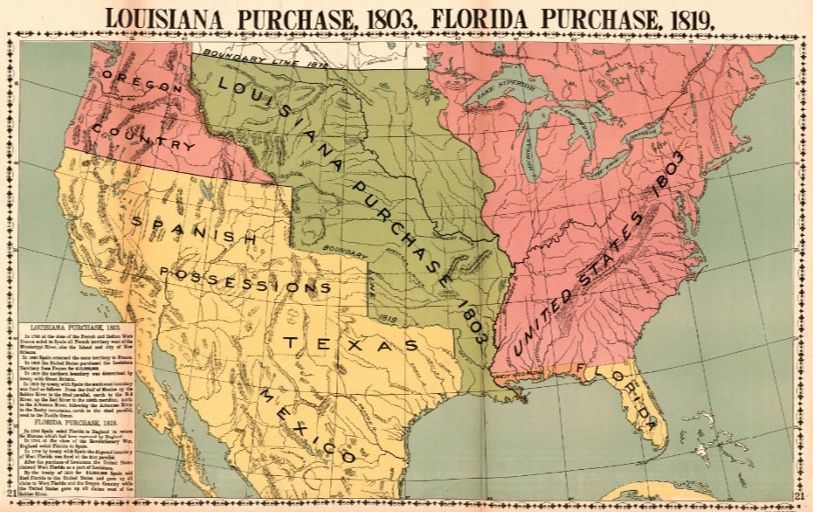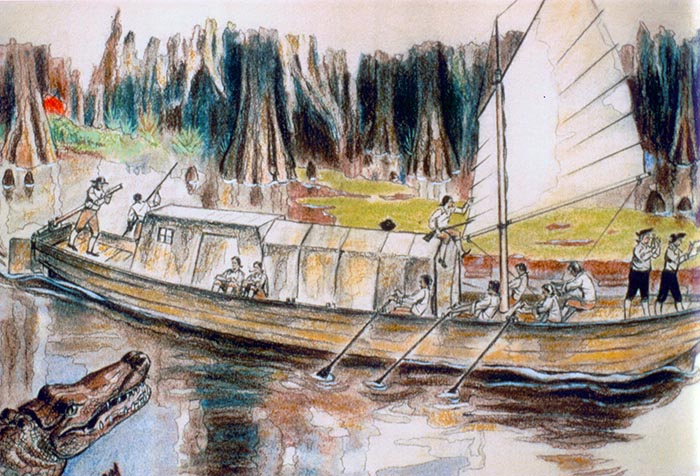Like any proud new land owner, it was time to explore your new land-ownings. The Louisiana Purchase of 1803 doubled the size of the United States and, most being bought sight unseen, it was imperative that the U.S. explore and mark the boundaries of their new territory. Making the matter of greater importance was the fact that Spain and Great Britain claimed some of the same land and permanent boundaries needed established.

Every school child has studied the Lewis and Clark expedition that traversed the country by proceeding up the Missouri River and across the Rockies to the Pacific Ocean. Actually, that was just one of the four missions of exploration and the other three are virtually forgotten. In 1806, the Pike Expedition traveled up the Missouri, crossed over to the Arkansas River Basin, and explored much of Colorado and the inter-basin region. Another group attempted a journey up the Red River with little success.

The fourth group is known and the Dunbar expedition and the notes, artistic sketches, and scientific information collected by this group provides great insight into the animal and plant life of Arkansas and Louisiana. William Dunbar, an aristocratic landowner in Vicksburg, Mississippi was a well-known and respected friend of Thomas Jefferson. With his close ties to the region and its people, he was a natural for Jefferson to select to lead the expedition. To assist, Jefferson assigned a chemist and druggist by the name of George Hunter. Hunter has previously explored areas of the Ohio and Indiana frontier and was known for his ability to record the scientific data collected.
Originally the expedition would have traversed the southern portion of the purchase, traveling up the Red and Arkansas River and into the interior of the new nation. If not for the uprising of the Osage Indian tribe, the expedition would have rivaled that of Lewis and Clark. Fearing trouble from the warring tribes, the trip was scaled back to an exploration up the Red River and into Arkansas through the Ouachita River. Today, we know the Ouachita River begins in the mountains of western Arkansas near Mena, Arkansas and winds for six-hundred miles through Arkansas and Louisiana before joining the Red and Black River as a tributary of the Mississippi. A beautiful scenic river, the Ouachita comes from the Indian word Washita which means sparkling silver water.
Dunbar and Hunter were provided 3,000 dollars to fund their journey. Purchasing supplies and a boat, they journey upstream from the Mississippi and Red River and entered the Ouachita. Near present day Monroe, Louisiana the water became too shallow for their boat requiring them to rent a keel boat with little draft as they proceeded up-stream. Hunter took copious notes along the way and both he and Dunbar recorded various encounters with the native Indian tribes as well as with the scattered French, Spanish, and English settlers already living within the area. By November, the crossed into what is now Union County and Camden. They proceeded upstream, having heard of and wishing to explore, the healing hot springs of central Arkansas. The men struggled against the river current as they hauled, rowed, or pulled the boats upstream. Near modern day Malvern the men heard a tremendous noise, compared by Dunbar to the sounds of a hurricane he once encountered in New Orleans. Stretching before them was white water ripping through a land-mine of boulders. Stretching for a mile, the rapids known as the chutes, was a formidable obstacle.
Eventually overcoming the obstacle of the chutes, Dunbar and his men reached the mouth of Gulpha creek and thus travelled overland to the Hot Springs. They noted that there was one ormore uninhabited cabins near the springs, thought to have been constructed for individuals that came to sample the healing waters. Intrigued by the many stories, the men began an extensive study of the springs and of the animals and plants in the area. Christmas day found them recording the temperature and composition of the waters. They remained in the area until January 8, 1805. They were some of the first to describe the limestone formations, the organisms living in the hot waters, and even the temperatures of the various springs.
On the return trip, they meet the Frenchman Jean LeFevre who had lived in the region for years. Lefevre provided a wealth of information about the surrounding region and its people. Upon his return, Dunbar’s notes and journals were sent to Jefferson, arriving more than a year before Lewis and Clark returned from their expedition. Although smaller in scope, the President received his first glimpse into the new lands acquired through the Louisiana Purchase. Today, we might call Dunbar’s the Forgotten Expedition.






